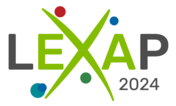Speaker
Description
Quantum Electrodynamics (QED) postulates that the photons emitted during the self-annihilation of the singlet state of positronium atoms (Ps) in a vacuum are maximally entangled in their polarization [1]. Despite theoretical support for this behavior, experimental verification has proven to be challenging [2,3]. This challenge may arise from the interference of alternative decay processes, such as direct positron-electron annihilation, the decay of the triplet-state of Ps via the pick-off process, or its conversion to singlet state via spin-exchange reactions with paramagnetic molecules such as $O_2$ [4], induced by the medium. In this study, we investigate the potential of the J-PET detector to explore the polarization correlation of two photons generated from positron annihilation in a porous medium. Constructed with plastic scintillators, it allows for the estimation of photon polarization via Compton scattering [5-7]. The inclusion of positron lifetime as an additional parameter serves to differentiate between decay processes, thus aiding in the examination of photon polarization correlation as a function of positron lifetime inside the medium. Understanding this correlation not only contributes to our fundamental knowledge of entanglement in the high-energy domain but also holds potential for advancements in PET imaging techniques [3,4].
In my presentation, I will outline the key features of the J-PET detector, with a particular emphasis on its capacity for measuring the polarization of high-energy photons [8]. Furthermore, I will present the results observations concerning the polarization correlation of photons produced from positron annihilation within a porous medium, leveraging the assessed lifetime of positrons.
References:
[1] H. S. Snyder et al., J Phys. Rev.73, 440 (1948).
[2] A. Ivashkin, et al., Scientific Reports 13, 7559 (2023).
[3] D.P. Watts et al., Nature Commun. 12, 2646 (2021).
[4] S.D. Bass et al., Rev. mod. Phys. 95, 021002 (2023).
[5] O. Klein, Y. Nishina, Y. Z. Physik 52, 853 (1929).
[6] P. Moskal et al., Eur. Phys. J. C 78, 970 (2018).
[7] P. Moskal et al., Acta Phys. Polon. B 47, 509 (2016).
[8] P. Moskal et al., Nature Commun, 15,78(2024).

